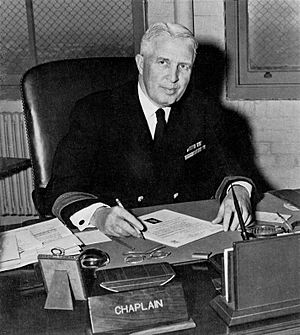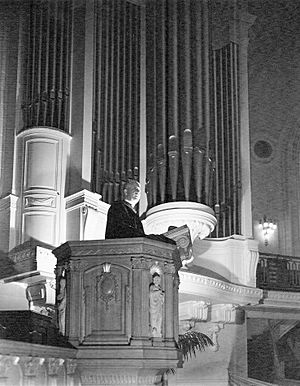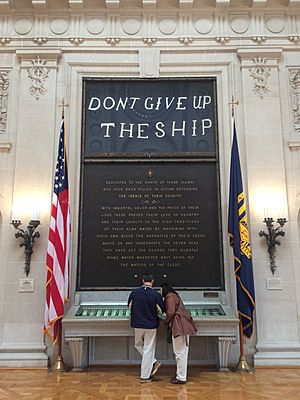William Nathaniel Thomas facts for kids
Quick facts for kids
Chief of Chaplains
William Nathaniel Thomas, photo courtesy of USN archives
|
|
|---|---|
 |
|
| Birth name | William Nathaniel Thomas |
| Born | March 21, 1892 Piney Woods, Mississippi |
| Died | April 26, 1971 (aged 79) Lake Junaluska, North Carolina |
| Buried |
Arlington National Cemetery
|
| Allegiance | United States of America |
| Service/ |
Navy |
| Years of service | 1918–1949 |
| Rank | Rear Admiral |
| Unit | Navy Chaplains Corps |
| Commands held | Chief of Chaplains of the U.S. Navy; Command Chaplain of the U.S. Naval Academy; USS Pennsylvania; Assistant Chaplain of the U.S. Naval Academy; USS West Virginia; USS Raleigh; USS Madawaska; shipboard captain |
| Awards | Legion of Merit; Victory Medal with Transport class; Victory Medal World War II; the American Defense Campaign Service Ribbon; American Area Campaign Ribbon; |
| Spouse(s) | Ellen Fondren Thomas (married March 1913) |
| Children | William N. Thomas, Jr., John Edward Thomas |
| Relations | William N. Thomas, Jr. |
| Other work | Chaplain of the Lake Junaluska Methodist Church |
William Nathaniel Thomas (March 21, 1892 – April 26, 1971) was a very important US Navy chief of chaplains. Many people say he was one of the best chaplains to ever serve in the Navy. He was born in Mississippi and joined the Navy in 1918. He became a high-ranking officer, a Rear Admiral, and led all Navy chaplains from 1945 to 1949.
He served on several ships, including the USS Madawaska during World War I. He also worked at the United States Naval Academy in Maryland. There, he wrote the famous Prayer of the Midshipman. He also wrote the dedication for Memorial Hall at the Naval Academy.
Contents
Early Life and Education
William "Will" Thomas was born on March 21, 1892. He grew up in Cato, Mississippi, as the oldest of seven children. His family had some Choctaw heritage. His father helped start the D'Lo Methodist Church, which was near their home. It was there that Will felt called to become a preacher. He received his preacher's license when he was just sixteen.
He worked hard to pay for his studies at Millsaps College in Mississippi. He graduated with honors in 1912. His goal was "To do good rather than be conspicuous." After college, he became a "circuit-rider" preacher. This meant he traveled by horse and buggy to serve many small churches. In 1913, he married Martha Ellen Fondren. She once said she would never marry a preacher, but that was before she met Will! He continued his religious studies and was ordained in 1915. He also earned an honorary Doctor of Divinity degree in 1935.
When the United States entered World War I in 1917, Will Thomas wanted to help. He tried to join the Army, but they didn't need chaplains. So, he joined the Navy instead, even though he had never seen a naval officer. He officially joined on January 5, 1918.
His first assignment was on the USS Madawaska. This ship transported American soldiers to Europe and back. He served on the Madawaska from February 1918 to September 1919. He crossed the Atlantic Ocean 28 times, helping soldiers travel. He quickly realized he loved the Navy and its people.
After the war, he worked at a hospital in Colorado from 1919 to 1922. Many patients there were soldiers who had been injured in the war. He became a lieutenant in 1920. Next, he served on the USS Pennsylvania from 1922 to 1924.
His first time at the United States Naval Academy was from 1924 to 1927. He worked as an assistant chaplain. He also held services on the USS Reina Mercedes, a ship used for training at the Academy. He was promoted to lieutenant commander in 1924. From 1927 to 1929, he served on the USS Raleigh. This ship went on a goodwill tour to Europe and Africa. People said he had prayed for more foreign leaders than any other Navy chaplain. He then served in Hawaii from 1929 to 1932. His last ship duty before a long shore assignment was on the USS West Virginia from 1932 to 1933.
A very important part of Chaplain Thomas's career was at the Naval Academy. He was the Command Chaplain from June 1933 to June 1945. He spent twelve years there, which was a very long time. Many future Navy officers got to know him during their time as midshipmen.
The Midshipman Prayer
For many years, no one knew who wrote the Midshipman Prayer. Chaplain Thomas wrote it in 1938 because some midshipmen asked him to. This prayer shows his beliefs and what he thought a good Navy officer should be like. He never took credit for it, but it has been used in the Naval Academy Chapel ever since. A bronze plaque of the prayer is in the chapel.
While at the Academy, he performed 800 weddings and 700 baptisms. He often had services very close together on graduation days. He also helped with the Academy's Christian Association. He often invited midshipmen to his home.
Chapel Enlargement
Chaplain Thomas also oversaw the expansion of the Academy Chapel. It was sometimes called the "Cathedral of the Navy." The chapel was made larger, adding a thousand more seats. He replaced cannons at the entrance with anchors. He believed that "religion should be the anchor of a naval officer's life." A new pulpit was added, and a votive ship was installed. The larger chapel was rededicated on April 28, 1940. He also helped bring Jewish clergy to the Academy.
He invited many famous ministers to speak at the Academy, like Peter Marshall. On December 7, 1941, Peter Marshall gave a famous sermon called "Rendezvous in Samarra." After the service, everyone learned about the attack on Pearl Harbor. Chaplain Thomas had served on three ships that were at Pearl Harbor: the USS Pennsylvania, the USS Raleigh, and the USS West Virginia. Before his sermons, he would honor Naval Academy graduates who had died serving their country. In 1943, he received another honorary Doctor of Divinity degree.
After World War II
Chaplain Thomas was one of only 39 chaplains who served in both World War I and World War II. He would have preferred to stay at the Naval Academy. However, he became the seventh Chief of Chaplains in Washington, D.C., on July 1, 1945. He was a Rear Admiral, but he preferred to be called "Chaplain." He felt that the title of admiral belonged to someone who commanded ships. He liked being a minister more than an administrator.
After Japan surrendered, President Truman asked Chaplain Thomas and the Army Chief of Chaplains to lead a thanksgiving service at the White House.
After the war, Chaplain Thomas managed the process of sending chaplains home. He made sure chaplains had support as they left the service. He also helped create many new chapels, even at closed Navy bases. These chapels were also available for local community groups to use.
He helped finish the first history books about the Chaplain Corps. He also helped create the first official manual for Navy chaplains in 1947. He supported advanced studies for chaplains. It is thought that the idea of chaplains serving on destroyers, traveling between ships, came from his own experience as a "circuit rider" preacher in Mississippi. In January 1947, Chaplain Thomas received the Legion of Merit award.
In 1952, Chaplain Thomas wrote the dedication for Memorial Hall in Bancroft Hall at the US Naval Academy. This dedication was placed below the famous "Don't Give Up the Ship" flag.
Retirement and Later Life
Chaplain Thomas retired from active duty in 1949. He and his wife moved to Lake Junaluska Methodist Assembly. He served as the dean of the Memorial Chapel there. He also preached in many local churches. When asked about serving different church groups, he joked that he "dehydrated the Baptists, thawed out the Presbyterians and quieted down the shouting Methodists."
He was active in his community and enjoyed golf, reading, gardening, and woodworking. He also continued to perform weddings. He once said he would rather "tee off on the golf course than to do it at people." He passed away on April 26, 1971, at 79 years old.
Personal Life and Family
William Nathaniel Thomas married Martha Ellen Fondren (1892–1990) on February 18, 1913. They had two sons, both of whom served in the US Navy.
- William Nathaniel Thomas Jr. (1919–2013) became a doctor. He joined the Navy in 1943 and was a lieutenant in the medical corps. He was injured while serving as a surgeon during the Battle of Okinawa. After the war, he became a radiologist in Annapolis, Maryland.
- John Edward Thomas (1930–1993) studied psychology. He joined the Navy in 1952 and served for three years during the Korean War. He became a lieutenant junior grade and was an executive officer on a ship.
Death and Legacy
Chaplain Thomas wanted a simple funeral. A memorial service was held at the United States Naval Academy Chapel. He is buried on Chaplains Hill at Arlington National Cemetery in Virginia. His wife was buried next to him in 1990.
He once said, "A Chaplain's personal life is his most effective sermon." In 1980, the path around the USNA Chapel was named "Thomas Walk" in his honor.
Awards and Honors
- Victory Medal with Transport Clasp
- American Defense Campaign Service Ribbon
- American Area Campaign Ribbon
- Victory Medal, WWII
- Legion of Merit (1947)
- Honorary Doctor of Divinity from Millsaps College (1935)
- Honorary Doctor of Divinity from American University (1943)
Notable Works and Contributions
- The Prayer of a Midshipman (1938)
- The Dedication in Memorial Hall at the US Naval Academy
- Thomas Walk encircling the USNA Chapel




